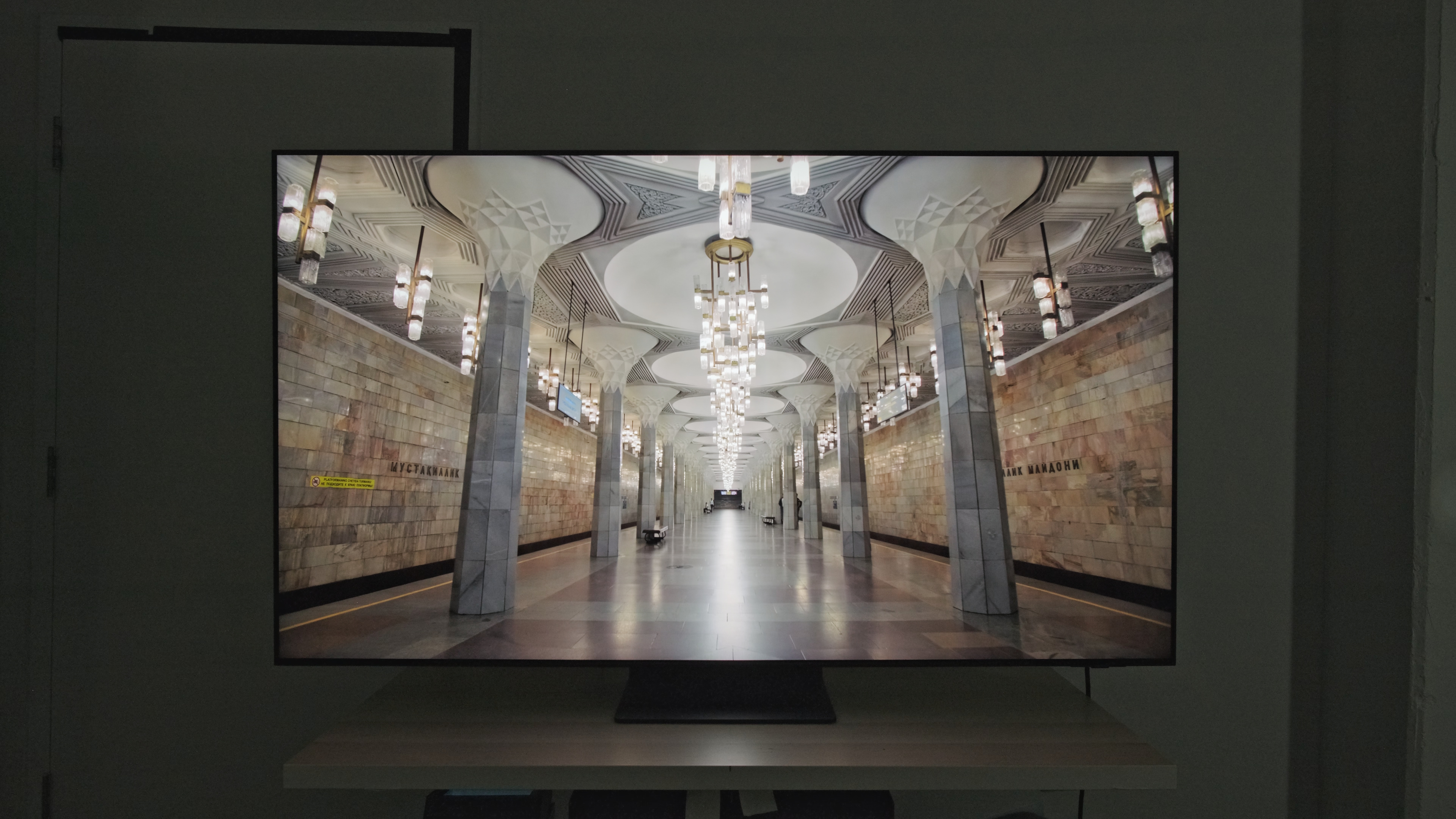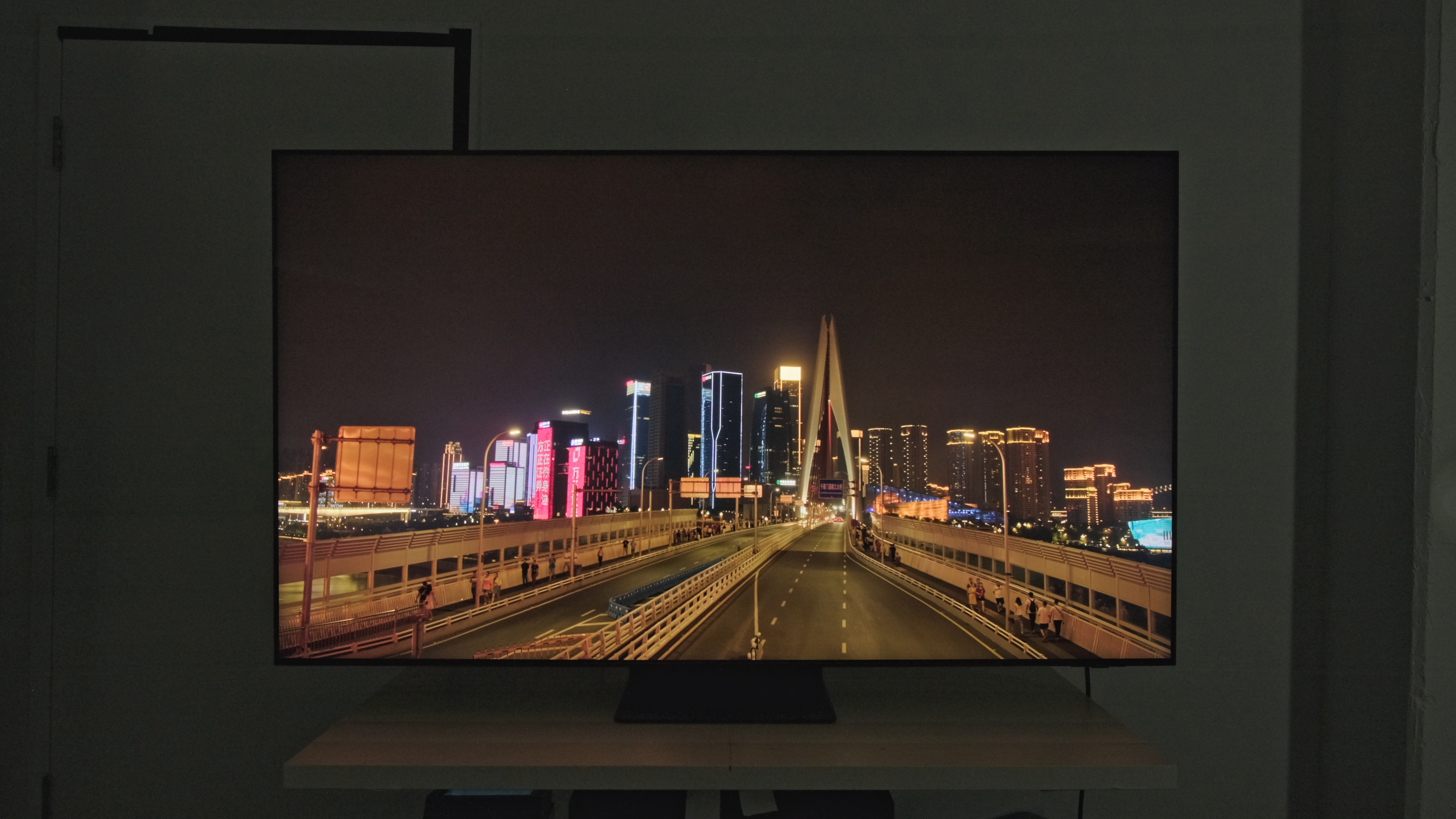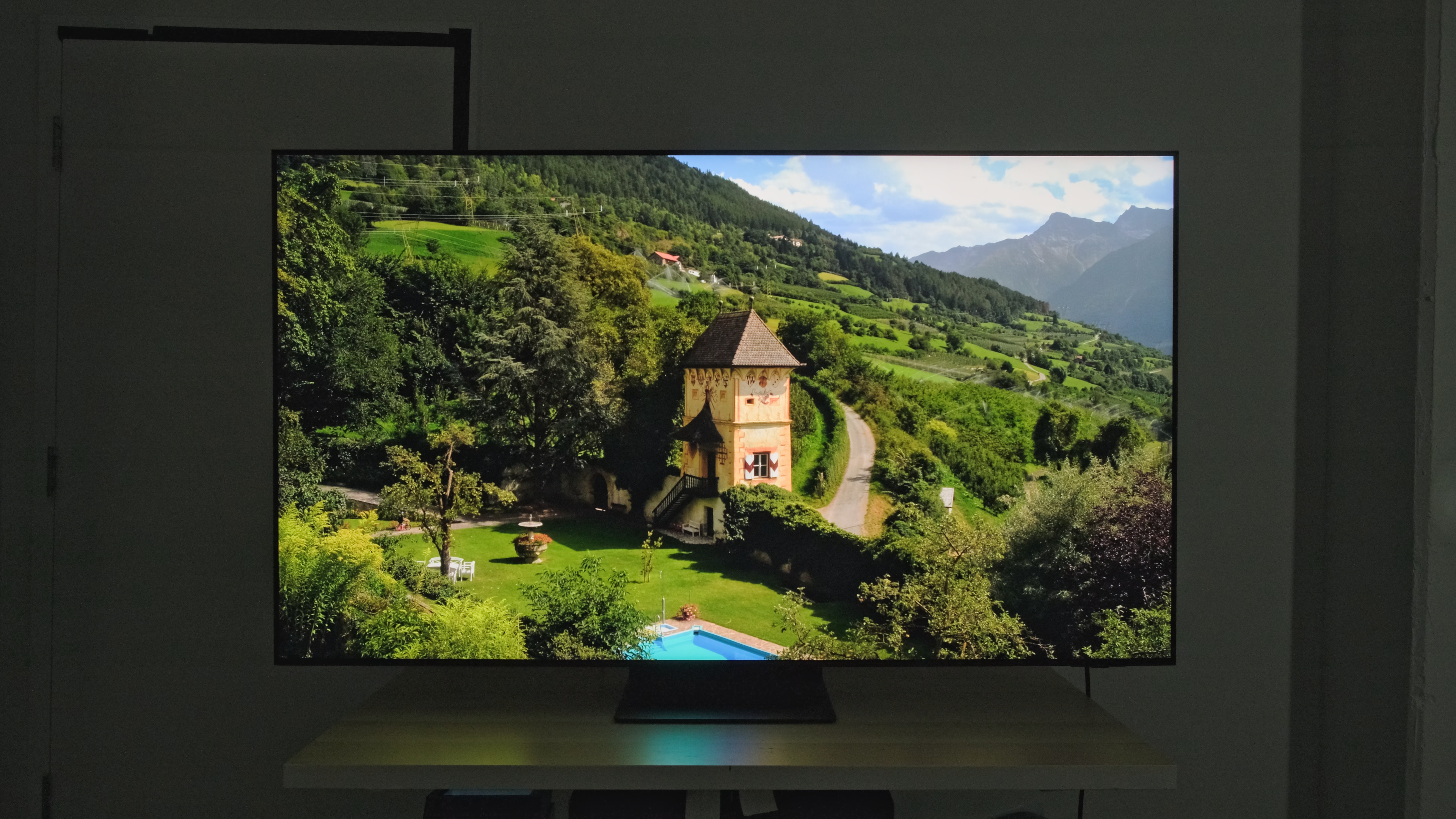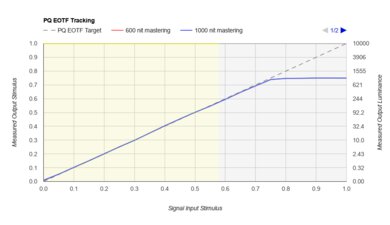- 9.0% Hallway Lights (~1950 cd/m²)
- 9.0% Yellow Skyscraper (~700 cd/m²)
- 9.0% Landscape Pool (~300 cd/m²)
- 2.0% Peak 2% Window
- 2.0% Peak 10% Window
- 2.0% Peak 25% Window
- 2.0% Peak 50% Window
- 2.0% Peak 100% Window
- 1.0% Sustained 2% Window
- 1.0% Sustained 10% Window
- 1.0% Sustained 25% Window
- 1.0% Sustained 50% Window
- 1.0% Sustained 100% Window
- 1.0% Automatic Brightness Limiting (ABL)
HDR brightness is a measure of how bright a TV can get while displaying HDR content. Higher peak brightness results in brighter highlights that stand out better.
For these tests, we take measurements of the brightness of a few white rectangles in HDR, each covering different sizes on the screen. The measurements are in cd/m², also known as 'nits'. We also display real content on the TV and measure specific points on the TV to see how well it handles bright highlights.
Test results
When It Matters
While SDR Peak Brightness is mainly important if you're in a bright room to help it overcome glare, a higher peak brightness in HDR has more to do with the overall picture quality. This allows a TV to display brighter highlights and, in most cases, more vivid colors, so it's important to get a bright TV for a true HDR experience. Learn more about HDR.
For this test, we measure how bright a TV can get when displaying HDR content. We test this in two different ways: first, we take brightness measurements with static slides that represent different types of content. Second, we measure the brightness of specific points of light in actual content. We also measure how accurately the TV tracks the PQ EOTF function, or in other words, how accurately a TV tracks the content creator's intent.
Our Tests
We take two sets of peak brightness measurements when measuring HDR peak brightness on TVs. The first set of measurements is with five different test slides. We measure the peak brightness in the most accurate HDR Picture Mode, with the backlight at max and after calibrating the white point to 6500K.
We use five different test slides to measure the peak brightness of the display with different types of content. We also check to see if the TV can maintain the same brightness level or if it decreases over time. These slides are sent to the TV using a computer, and we use a Colorimetry Research CR-100 to take the measurements.
We also take three measurements with real scenes sent to the TVs by our Murideo 7G generator. These three tests make up the bulk of our scoring. After all, except for our TV testers, most people don't spend all day watching test patterns. These three scenes vary greatly in average picture level (APL), which is the average brightness of the scene, so they push the TVs to their limits to see how well they can handle both bright scenes and small bright highlights in relatively dim scenes. Unfortunately, although we have permission to use these source clips for our tests and to post our results, for legal reasons, we can't share the original files. Again, we use a Konica Minolta LS-100 Luminance Meter to take the measurements.
Hallway Lights
For our first real scene photo, we display this bright hallway scene. We measure the peak brightness of the two bright lights at the top of the scene and record the brightest measurement of the two. The small highlights are coded to be very bright, so on an ideal TV, they should measure around 1,950 cd/m². Aside from the two bright highlights, the entire scene should be bright, so on TVs that lack a local dimming feature or have a low peak brightness, like the Hisense A6G below, the entire scene is dim and fine details are hard to make out in the darker areas of the scene.
 Samsung QN90B QLED Hallway Photo: 1,099 cd/m²
Samsung QN90B QLED Hallway Photo: 1,099 cd/m²Yellow Skyscraper
For the skyscraper real scene photo, we display this night scene of a cityscape and measure the peak brightness of the bright yellow skyscraper next to the arch of the bridge. On an ideal TV, this very bright highlight should be at around 700 cd/m². Interestingly, due to the relatively low average picture level (APL) of this scene, many of the brightest TVs on the market display this highlight brighter than it should be, even on TVs that don't reach the target brightness with our other real scene tests. Comparing the Samsung QN90B QLED to the Hisense A6G below, the fine details in the entire scene are much more difficult to make out, and the skyscraper doesn't stand out much from the surrounding towers.
 Samsung QN90B QLED Cityscape Photo: 1,222 cd/m²
Samsung QN90B QLED Cityscape Photo: 1,222 cd/m²Landscape Pool
For the landscape real scene photo, we measure the peak brightness of a small triangle on the pool along the bottom edge. On an ideal TV, it should measure around 300 cd/m². Continuing with the Samsung QN90B QLED and the Hisense A6G examples above, here you can see the benefits of the brighter QN90B. The absolute difference in peak brightness isn't as significant as it was on the previous scenes, but you can clearly see the difference across the entire scene, as the Samsung looks significantly brighter and more lifelike. The Hisense, on other hand, looks dull and lacks detail.
 Samsung QN90B QLED Landscape Photo: 409 cd/m²
Samsung QN90B QLED Landscape Photo: 409 cd/m²HDR Peak Window
Our peak window tests measure the maximum brightness of a white rectangle displayed on an area covering a certain percentage of the TV’s screen. This provides an idea of how bright a small highlight—the sun, a distant explosion, etc.—might look on-screen, but the larger areas can also represent very bright areas, like if you're watching something with a bright sky.
For this test, we display each of the five slides shown above, representing 2%, 10%, 25%, 50%, and 100% APL (Average Picture Level). We use a Konica Minolta LS-100 Luminance Meter connected to a PC to measure the luminance of the square of light over time. This allows us to see not only the peak brightness of the TV but also to capture the sustained brightness over time for the next test.
HDR Sustained Window
We measure the HDR sustained window with the same test images as the HDR peak window tests, but the only difference is that we test for brightness after the window has been displayed for a few seconds. This allows the TV to 'stabilize' its brightness and is more representative of content with bright areas that stay on for an extended period, like on a hockey broadcast.
Unlike with SDR, it's not uncommon for TVs to dim over time when displaying HDR content. This is because bright highlights like this usually aren't sustained when watching HDR content—they're meant to give an impressive flash of light for a few seconds, like during an explosion.
Automatic Brightness Limiter
TVs use algorithms to limit how bright the screen gets, especially with large areas, like in our 100% peak window test. This is done to prevent the entire screen from getting too bright and damaging internal electronics. What this essentially means is small areas get brighter than large areas, and we want to know just how much difference there is between the two. Our Automatic Brightness Limiter (ABL) coefficient variant calculates for the difference in brightness between the sustained windows tests after normalizing for noticeable differences with the Perceptual Quantizer (PQ) EOTF. This means we only calculate the noticeable differences that we can see when watching TV.
A TV with an ABL of 0 means that the brightness doesn't change across different content. A high ABL is usually found on OLEDs, as large areas are noticeably less bright on those TVs. Also, it's possible for small highlights to be less bright than larger areas because of frame dimming on some TVs. ABL isn't something you should worry about too much if you just watch SDR content, but it's more important for HDR content.
HDR Game Mode
- 9.0% Hallway Lights (~1950 cd/m²)
- 9.0% Yellow Skyscraper (~700 cd/m²)
- 9.0% Landscape Pool (~300 cd/m²)
- 2.0% Peak 2% Window
- 2.0% Peak 10% Window
- 2.0% Peak 25% Window
- 2.0% Peak 50% Window
- 2.0% Peak 100% Window
- 1.0% Sustained 2% Window
- 1.0% Sustained 10% Window
- 1.0% Sustained 25% Window
- 1.0% Sustained 50% Window
- 1.0% Sustained 100% Window
- 1.0% Automatic Brightness Limiting (ABL)
We also repeat the above tests, both real scene and with the slides, but now measure the HDR brightness in Game mode. Our testing isn't any different as we use the same video and slides, but we simply put the TV in 'Game' mode. On some TVs, 'Game' mode is simply a setting that allows the lowest input lag, while on others it's a picture mode entirely different from the one we normally use in the regular HDR test. Most TVs don't get significantly dimmer in 'Game' mode, but Samsung models like the Samsung Q80/Q80T QLED do, so the HDR experience isn't the same when gaming.
Additional Information
PQ EOTF
 Sony A95K OLED - Fantastic PQ EOTF Tracking
Sony A95K OLED - Fantastic PQ EOTF TrackingIn HDR, the PQ Electro-Optical Transfer Function, or EOTF for short, is the mathematical function that a TV uses to convert the digital signal encoded in the content you're watching into brightness. In short, it converts the 1s and 0s that define how bright a scene should be into the actual light output on the screen. Even though it's not part of our HDR brightness testing, the PQ EOTF plays an integral part in how well HDR content is displayed on your TV. We measure the PQ EOTF as part of a separate test and display the results as a graph.
Linearizing Luminosity
For the ABL calculation to be significant, it should correspond to the way we perceive different luminosity levels. The eye is much more sensitive to small changes in luminosity in a dark environment than a bright one, so although the measured change in luminosity may be the same, the brighter source is better because we don't notice the change in brightness as much. Essentially, if a screen goes from 25cd/m² to 20 cd/m², it's more noticeable than a screen going from 100 cd/m² to 95 cd/m². This linearization is done with the PQ EOTF, as you can see below.

Each step of 1/4096 along the PQ curve shows the nonlinear relationship between the target luminosity (vertical axis), and a similar, just noticeable difference in the stimulus (horizontal axis)
PQ is a function that relates luminosity with noticeable differences in brightness. When the PQ curve is divided into 4096 segments (12-bit), there are smaller steps that relate to the change in brightness; the horizontal dotted lines represent each step, and as you can see, the first step in each segment represents a higher change than the last segment. We use this to linearize all of our luminosity measurements for this test, ensuring the ABL best represents what's seen.
How To Get The Best Results
Increase bright highlights
Some TVs offer different highlight brightening settings, and often these settings require the enabling of local dimming. This combination can lead to light blooming off bright highlights, like a glowing effect when there are small light sources in a dark scene. This can get distracting and negatively impacts the picture quality.
For that reason, you should choose the highlight setting that you enjoy the best. This may mean getting the brightest highlights your TV is capable of, or it might mean settling for slightly dimmer highlights that come with less blooming.
Recommended Settings
- Backlight/Brightness/OLED Light: These settings are what increase the luminosity. The majority of LED TVs call it Backlight, but Samsung and Sony use Brightness. On OLEDs, it's usually called OLED Light, but the Vizio OLED 2020 has a Luminance setting. Whatever they're called, these settings are meant to adjust the luminance and are the best setting to use to get the brightest image possible. When watching HDR content, this setting is usually automatically set to the maximum setting; we recommend against changing it, as in HDR, the content itself sets the brightness of the scene, so reducing this setting will reduce the brightness of everything you watch.
- Local Dimming: Some LED TVs include a feature that darkens the backlight to make blacks extra dark, and sometimes this feature even makes highlights even brighter. Local dimming isn't always perfect, as it could cause blooming around bright objects. Learn more about local dimming
- Contrast: The contrast setting increases the brightest white, which could help increase the overall luminosity. However, changing this setting also affects picture quality, so we don't recommend changing it for the most part.
- Brightness: Opposite of contrast, the brightness setting controls the black level, and on some TVs, the setting itself is called 'Black Level'. Decreasing it makes blacks darker, but that means you can easily lose details, so we don't recommend changing it.
- Gamma: Gamma affects the brightness of the overall scene, but it doesn't impact the luminosity. In our testing, we want TVs to follow a gamma target of 2.2; anything higher results in a darker overall image and lower means the image is brighter. Some TVs have gamma settings, so you should change it to your liking if you notice the overall image is too dark, even if you have the backlight at its max.
- Eco Mode/Light sensor: Some TVs use a sensor to detect how much light is in the room and adjust the backlight accordingly. It can be helpful, but it can also change the brightness often while you're watching, so it's best to turn it off.
At the end of the day, you're the one watching TV, so if you want the make the image brighter, do whatever it takes to make it look better for your viewing experience. These are just generalized recommendation settings, and it changes between TVs.
Conclusion
A TV’s brightness indicates how bright images can get on the screen. TVs with high brightness help deliver a better HDR experience, as they allow for highlights to stand out the way the creator intended. We test for a TV's brightness to know exactly how bright it can get, but also to see if it remains a consistent brightness level across different content.







